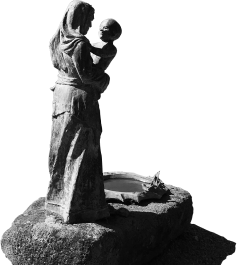Here at Notre Dame Priory we celebrated yesterday our first patronal feast as a community. As you may know, there is no existing feast of Our Lady of Cana in the Roman Liturgy, even though the mystery is commemorated today, the Second Sunday after Epiphany. We have, with provisional permission from the Archbishop of Hobart, put together, thanks to the copious writings of the saints on this mystery, a proper office for the feast which we celebrate on the Saturday after the Epiphany — which this year, was yesterday — and for which we hope to get approval from the Holy See.
Why is the mystery so important? And why was it chosen as the guiding star for our community? Our Lady’s humble but clear petition to Her Son has always been an inspiration for authentic prayer: one makes known in all simplicity one’s needs to the Lord, without going into all the details, for He knows them and He loves us. One presents one’s need, in utter confidence that, since He loves us, He will answer our prayer in the best way possible. The need at hand in Cana was wine. On a purely literal reading, it would appear that Our Lord stoops down to give something that seems quite worldly and not essential. In this sense, His great love and compassion are made manifest.
But there is much more. The water symbolises us, our frail efforts at doing good to please God and save our soul. But whatever effort we put into it, it remains insipid, there is no energy, no sweetness. The wine symbolises the sweetness and warmth of the divine love that truly gives life, eternal life to our actions performed in time.
So if we feel that we are running out of wine, or if we have long been without it; if we can sense that our spiritual life is not getting anywhere, then let’s go to the Lady of Cana, and ask Her to go to Jesus for us, and asks Him to transform our weak efforts into something sweet, something warm and lasting, that we may relish the sweetness of God.
There is also the entire mystic of the nuptials. Salvation history begins with a wedding, that of Adam and Eve; and it concludes with the eternal marriage feast of the Lamb, God who weds all the elect to Him in a spousal union. And in the middle of this history, Our Lord chooses to perform His first miracle at a wedding. For sure, Our Lord’s presence there sanctified marriage and raised it to the level of a sacrament, but it also symbolised the spousal nature of our very existence and our call to love and eternal fidelity to God.
As monks, we vow our entire lives to God; we forego the joys of married and family life to taste, already in this life, the peace of a spousal union with God. But that does not make us oblivious of married couples and families, on the contrary; it gives us a great desire to help them live up to the marvellous plan God has in store for them. And this is all the more important in an age which seeks to destroy the family.
May Our Lady of Cana bless all married couples; may she open their hearts to welcome with generosity all the children God will give them without seeking to dictate their desires to God; may she heal the hearts of all those who have a distorted notion of the real meaning of married love and family; may she heal the broken families, and mend all wounds of the soul; and may she give to those who are consecrated to virginity or celibacy the grace to be faithful to so lofty a calling and to thus be a model of unconditional love and surrender to the Eternal Bridegroom.


